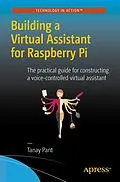Building a Virtual Assistant for Raspberry Pi walks you through various STTs and TTSs and the implementation of these components with the help of Python. After that you will start implementing logic for handling user queries and commands, so that the user can have conversations with Melissa. You will then work to improve logic handling to detect what the user wants Melissa to do. You will also work on building some useful applications/modules for Melissa, which will allow you to gain interesting information from Melissa such as the time, weather information, and data from Wikipedia.
You will develop a music playing application as well as a note taking application for Melissa, laying the foundations for how Melissa can be further extended. Finally, you will learn how to deploy this software to your Raspberry Pi and how you can further scale Melissa to make her more intelligent, interactive and how you can use her in other projects such as home automation as well.
What You'll Learn
- Design the workflow and discover the concepts of building a voice controlled assistant
- Develop modules for having conversations with the assistant
- Enable the assistant to retrieve information from the internet
- Build utilities like a music player and a note taking application for the virtual assistant
- Integrate this software with a Raspberry Pi
Who This Book Is For
Anyone who has built a home automation project with Raspberry Pi and now want to enhance it by making it voice-controlled. The book would also interest students from computer science or related disciplines.
Autorentext
Tanay Pant is an Indian author, hacker, developer and tech enthusiast. He is best known for his work on "Learning Firefox OS Application Development" which was published by Packt. He is also an official representative of Mozilla. He has been listed in the about:credits of the Firefox web browser for his contributions to the different open source projects of the Mozilla Foundation.
He also writes for a number of websites like SitePoint and Tuts+ where he shares tips and tricks about web development as well his opinions on different products. He digitally published Code Zer0 in his younger days to spread awareness about cyber security and hacker culture.
He is also the chief architect of Stock Wolf, a global virtual stock trading platform that aims to impart practical education about stocks and markets. This platform has acquired more than 100 colleges and has players from about 15 countries.Inhalt
Chapter 1: Introduction to Virtual Assistants
Chapter 2: Understanding and Building an Application with STT and TTS
Chapter 3: Getting Your Hands Dirty: Conversation Module
Chapter 4: Using the Internet to Gather Information
Chapter 5: Developing a Music Player for Melissa
Chapter 6: Developing a Note Taking Application
Chapter 7: Building a Voice Controlled Interface for Twitter and Imgur
Chapter 8: Building a Voice Controlled Interface for Twitter and Imgur
Chapter 9: Integrating Software with Raspberry Pi and Next Steps
